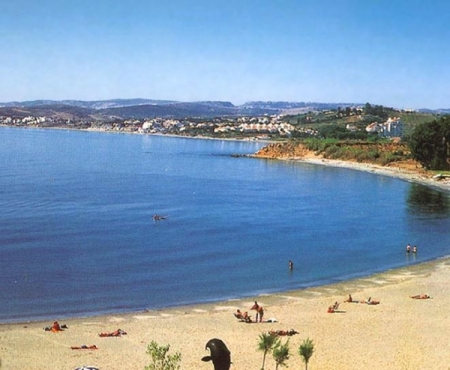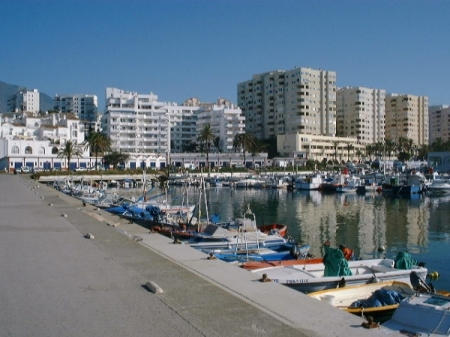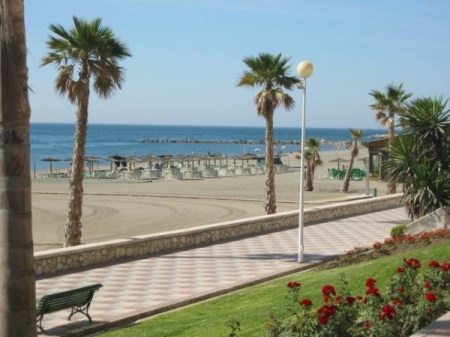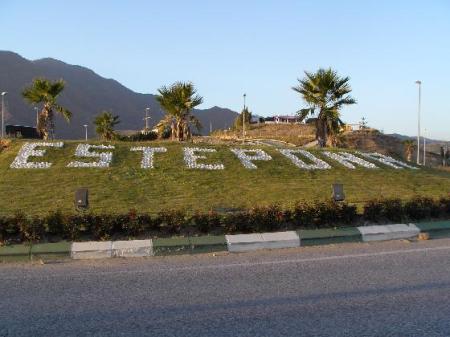Malaga is the capital city of the Costa del Sol, founded by the
Phoenicians as a colony some 3000 years ago it has come under the rule
of the Romans, the Carthaginians and the Moors. A city of some 600,000
inhabitants, it lives a Janus faced life as both a busy port &
industrial centre for the South of Spain, and the gateway to one of the
most popular holiday destinations in the world.
Often competing with its neighbour, Seville, as to which claims to be
the capital of the region of Andalucia – in reality neither is
officially recognised, though this doesn’t lessen the rivalry between
the two cities.
Malaga is a bustling little city, the old and the new meet on Marques de
Larios , Plaza de la Constitución and Calle de Granada , which form the
backbone of the shopping area and the thriving nightlife. The narrow
side streets form a confusing maze of alleys crammed with tapas bars and
bodegas – old fashioned wine shops brimming with casks including the
local sweet wine which is similar to Port.
The climate, with more than 300 days of sun and a year around average
temperature of 23ºC (73ºF), makes Málaga a perfect location to grow
olives and fruits like lemons and oranges. The perfect weather in Málaga
together with the many beautiful beaches in the area make the province
one of the most popular places for tourists to visit in Spain.
At weekends the area is full of young people going out to enjoy the
thriving nightlife in one of the cities many bars, bar de copas
(winebars), or nightclubs. Locals often do not go out until midnight and
will continue until morning light, catching some breakfast on there way
home.
Locality:
The lively city of Malaga, on the coast about 80 miles (129km)
southeast of Seville, is the gateway to Spain’s popular Costa del Sol
holiday resort region.
La Alcazaba – La Alcazaba is a military fortress
build by the Moors in the 11th century on the remains of a Romans
fortress. The fortress lies on a hill top with good view over the town
and the sea and originally consisted of 3 protecting walls (whereas 2
are still remaining), more than 100 towers and a superior part with a
residential area including 3 palaces.
Gibralfaro – The Gibralfaro Castle / Fortress is
situated just next to La Alcazaba which it is connected to by ducts from
two of its towers. Originally the place where the Gibralfaro lies is
thought to have hosted a lighthouse build by the Phoenicians. On the
remains of this lighthouse a fortress was build by Abderramán III and
was later reconstructed as a castle by Yasuf I in the 14th century.
Roman Theater – The Roman Theater is located just
below La Alcazaba. It was not discovered until 1951 in spite of it’s
size with a radius of 31 meters and height of 19 meters. Studies have
shown that it hasn’t been used since the 3rd century and that the Moors
used elements from the Theater in the construction of La Alcazaba.
Picasso Home – Museum (Fundacion Picasso) : The
early years of the life of Pablo Ruiz Picasso are closely linked to the
city of Malaga, where he was born in 1881. Family tradition also played a
large part in shaping his essentially malagueño character. His life and
works would later see him become the most famous native of Malaga of
all.
Tivoli World – Tivoli World is a theme park with many
exciting rides to choose from. Many of the rides are adapted for small
children and babies. There are daily shows varying from Andalusian
flamenco, Wild West Shows, an open-air theatre presenting live music,
ballet and children`s specials. There is a range of international
cuisine to choose from ranging from Texan to Russian
The Cathedral – The construction of the Cathedral in
Malaga began in 1528 after conquering Malaga from the Moors. It was
build on the top of a former Mosque, which was destroyed when the Moors
lost the town. The construction was not finished until 1782 and it
therefore shows many different architectural styles such as a Gothic
fundament, Renaissance facades and Baroque towers.
Sagrario Church – This Church is situated between
the Palace Episcopal and the Cathedral It was build on the ruins of the
major Arab mosque in the 15th century in a gothic style. Inside the
church there is a fascinating altar build Juan de Balmaseda.
Hiển thị các bài đăng có nhãn Malaga. Hiển thị tất cả bài đăng
Hiển thị các bài đăng có nhãn Malaga. Hiển thị tất cả bài đăng
Estepona Travel Guide
5/16/2012
Estepona is on the S coast of Spain and is the most westerly resort
on the Costa del Sol. It is 52 mls SW of Malaga and 47 mls SW of Malaga
airport. It is positioned on the coast, just off the main Malaga to
Cadiz road. The Sierra Bermeja mountains rise to the N, but the town
centre is flat.Estepona town is primarily a developed fishing village,
much less commercialised and more authentic than neighbouring resorts.
With many of its traditional elements intact, it has a less polished
atmosphere; older folk chat outside their front doors in the evening,
eyeing the passers-by as they have done for years. The buildings appear
more ramshackle than in other Costa del Sol resorts, with modern
apartments next to plainly time-worn establishments. However, it is by
no means behind the times; there is a pleasant, modern seaside promenade
and harbour area, and the needs of tourists are well provided for. The
whole Estepona resort area, however, covers around 14 mls of coastline,
which means that accommodation can be rather isolated, far from the main
amenities.
Estepona is well suited to families or couples looking for a
quieter, less commercialised resort. The accommodation is quite varied
and ranges from, from centrally located budget pensions to sprawling
5-star spa resorts some miles outside town; 10 apartment complexes
including a nudist option.The main beach in Estepona is generally wide
with coarse sand and some pebbly sections; it is backed by a wide
promenade with a few eateries. Jet-skiing and parasailing are quite
popular in summer. Beach quality deteriorates either side of the town
centre, so don’t count on a decent beach out of town.
Shoppers will find the central streets claim the best shopping areas,
with small local shops selling handicrafts, leather goods, ceramics etc.
A few quite expensive local boutiques.Entertainment in Estepona is
generally beach and water-based activities; exploring the old town
including Los Remedios church and the clock tower, Torre del Reloj
(organised tours every Thurs, departing from the tourist office); the
bullring, just outside town, has 4 small museums (local history,
archaeology, palaeontology and bullfighting); Sierra de las Nieves
Nature Park; tennis; golf; deep-sea fishing.
Nightlife is limited, apart from whiling away the hours at local
drinking establishments.Eating out offers traditional “tapas” bars and
the odd Argentinian restaurant in the town centre. The speciality is
seafood, with not a lot else on offer.
Getting around the area is made easy with frequent buses which run
between Estepona and Marbella, with a semi-regular service between
Estepona and Malaga, Torremolinos and Fuengirola. Less frequent runs to
other resorts. For transportation within the resort, there is a rather
expensive taxi service, operated from the sole rank at the harbour, just
E of the tourist office.
Đăng ký:
Bài đăng (Atom)











